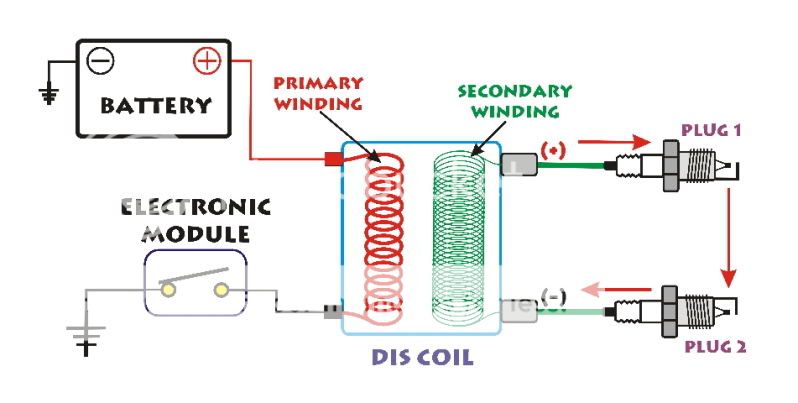So Fred W's point is correct, in that current flow is opposite in each plug on the coil. They each flow to ground, though, I don't follow that they complete the circuit through each other at ground. If I successfully learned to read (not a given by any means,) I see it as one plug has a high positive voltage and they other has a high negative voltage. Ground is 0 volts, so you still have the needed potential across the spark gap. The plugs are still parallel, not series. Think of it as a "tee," like so:
Without that ground, there is no circuit and no spark.
As for the impact of the direction of flow, the fine point of the iridium electrode is still the focal point of the spark, whether it "emits" electrons or "collects" them. I'd never considered the possible effect of moving a plug from one side of the coil to the other as stated in the article. My assumption is that the guy knows of what he speaks, but I saw no credentials. B) I
do know that the iridiums last longer, and by enough to offset the price difference.
No, the highlighted statement above is wrong, but you're getting closer.
First off one needs to understand that electric current is the flow of
electrons only. Electrons, being little negatively charged guys, will jump from one atom to another if attracted to it. They would be attracted to it if there are fewer electrons in the second atom (positively charge). That is what constitutes current flow. Big heavy protons don't jump from a nucleus (unless you are splitting atoms), so no need to worry about heavy protons colliding with the electrodes of your spark plugs.
Electrons will always flow from an area where there are excess numbers to a place where there are fewer. The absolute number of electrons is not as important as the difference between those two points. A place with a greater number of electrons is said to be negatively charged. A place with fewer electrons is said to be positive.
It's all relative. When we say that a location has a positive or negative voltage charge, that is always in comparison to some other specific location.
Although we say that ground is 0v, it is only 0v when compared to
itself. It still has plenty of electrons available. We just use ground as a "reference point" because it is such a common place in human life. After-all, we are all standing on it, so it's important to know how other places are charged compared to it, to prevent killing ourselves for one thing.
Assuming the schematic representation of the FJR coil is correct, it shows the secondary side of the FJR ignition coil (step-up transformer) is ungrounded. The secondary of the "transformer" has no grounded center tap. Therefore, whatever voltage is magnetically induced from the primary side of the coil to secondary side will be felt from one side of the secondary coil to the other. It will have no reference to ground. If there were a grounded center tap in the coil secondary then it would work as you describe above (two parallel circuits). But it doesn't, so it is a single series circuit with a single ground reference point at the plug side electrodes.
A quick way to verify that there is no ground in the coil secondary would be to disconnect any one spark plug wire and measure the wire's resistance to ground. With a center tap you would measure back through the low resistance of the coil to ground. If it really is not center tapped (as shown) the resistance will be infinite. Anyone with their tank off want to make a quick measurement?
If it really is as shown, that would also mean that when you disconnect one plug the other one in the coil pair would not fire either. Hmmmm...
Thinking out loud:
It also may explain why the Iridiums might work better. The two spark gaps each represent a certain "resistance" to current flow. Because they are in series they would each have 1/2 the coil's secondary voltage across themselves. Once one does arc over the resistance drops radically. So even though only one of the two plugs has the pointy negative electrode, because they are in series it would reduce the total arc-over voltage requirement for both plugs. The pointy plug would arc over first, which reduces its resistance, putting more of the total coil voltage across the non-pointy plug.



































